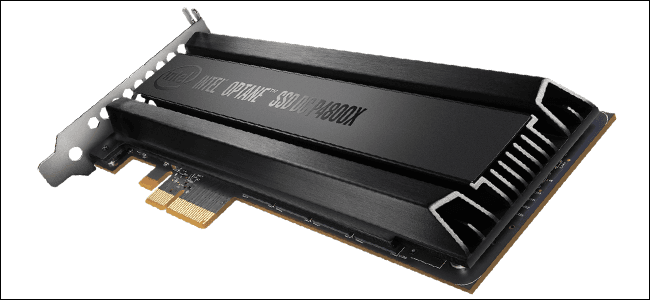
In the quest for ever-faster computers, Intel is constantly introducing new upgrades to its products to try and get a bit of extra cash out of enthusiasts and corporate customers. One of the company’s most dramatic introductions as of late has been its branded Optane memory, launched alongside the seventh generation of Core-series processors.
Unfortunately, Optane as a technology and an implementation is quite confusing, even once you get past the basic requirements. Here’s a primer on what Optane is right now… and what it might become later.
What Optane Memory Is
Optane is Intel’s trademarked term for a new class of hyper-fast memory modules. The name refers specifically to the memory itself, not an individual format, but at the moment it’s being marketed primarily in a specialized M.2 card, compatible only with supported motherboards that can use Intel 7th-gen Core processors (i3, i5, and i7 chips in the 7XXX series). Optane memory uses 3D NAND fabrication techniques and various proprietary technologies to achieve super-low latency—as fast as 10 microseconds.
What Optane Isn’t
Optane memory isn’t a type of conventional random-access computer memory, or RAM. And it isn’t a technology that’s being used for conventional storage—at least not at the consumer level, and not yet. Instead, the consumer M.2 Optane modules sold in 16GB and 32GB capacities are meant to work as a cache memory bridge between RAM and storage, allowing for faster data transfer between the memory, storage, and processor. This accelerates more or less every operation for the end user, especially when paired with caching software that intelligently stores relevant data on the Optane drive for near-instant retrieval.

Imagine an Optane memory add-on as a supercharger for a conventional gasoline engine: it’s not a required component to make the engine work, and it doesn’t replace any existing parts, it just makes the whole thing run faster.
The idea of using a small amount of super-fast flash storage to augment the performance of a primary storage drive isn’t new. In fact, Optane is basically a next-gen version of Intel’s Smart Response Technology (SRT), which could use cheap, low-capacity SSDs to cache data for slower, high-capacity conventional hard drives. The difference is that Optane uses memory manufactured and sold by Intel, in conjunction with special hardware and software components on compatible motherboards.
Why Not Just Make Faster Storage?
Funny you should ask that. While the Optane branding is currently limited to super-fast M.2 cache memory modules on the consumer side of things, Intel is already selling “Optane” storage drives for corporate data centers. These are closer to conventional SSDs, bringing that expensive, speedy memory right to the storage component of mission-critical servers. Right now, the only industrial-class Optane storage drive mounts just 375GB of storage directly to a PCI express slot, and those drives are selling for thousands of dollars in bulk orders to corporate customers—not exactly a wise investment for a traditional independent system-builder.

Intel has indicated that Optane-branded storage drives, both in the M.2 variety and in more standard 2.5-inch SSD form, will arrive for the consumer market at some point.
Can I Use Optane Memory Instead of DRAM or an SSD Drive?
No. The 16GB and 32GB Optane M.2 modules currently being sold do not function as primary computer memory, and they don’t replace a full storage drive.
How Much Faster Can Optane Make My PC?
According to Intel’s marketing material, adding an Optane M.2 memory module to a 7th-gen Core motherboard can speed up overall “performance” by 28%, with a 1400% increase in data access for an older, spinning hard drive design and “twice the responsiveness” of everyday tasks.
These claims are based on a series of benchmarks, the SYSmark 2014 SE Responsiveness subscore and the PCMark Vantage HDD Suite, so they’re fairly reliable. That being said, the actual hardware used to test those figures is hardly industry-leading: Intel used a mid-range Core i5-7500 processor, 8GB of DDR4-2400 memory, and a conventional 1TB hard drive with a speed of 7200RPM. That’s a decent system, but without the Optane add-on pretty much anything with an SSD installed will beat it for storage access and responsiveness.
Anandtech did a series of more intensive benchmarks using the same SYSmark 2014 test. They found that combining an Optane memory module with a conventional spinning hard drive could indeed increase overall system performance, in some cases beating out an SSD alone. But in each case, the performance was close enough that a simple SSD setup might be preferable to a hard drive plus Optane memory module, especially if you can afford to match the extra storage space with a 1TB or denser SSD. Performance improvements when pairing an Optane storage module with an SSD will be present, but much less dramatic.

Based on these findings (and on the limitations in the next section), Optane is ideal for someone who wants to use a single, large HDD with their system instead of a smaller but faster SSD.